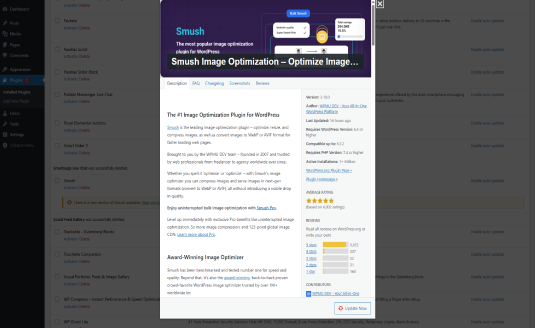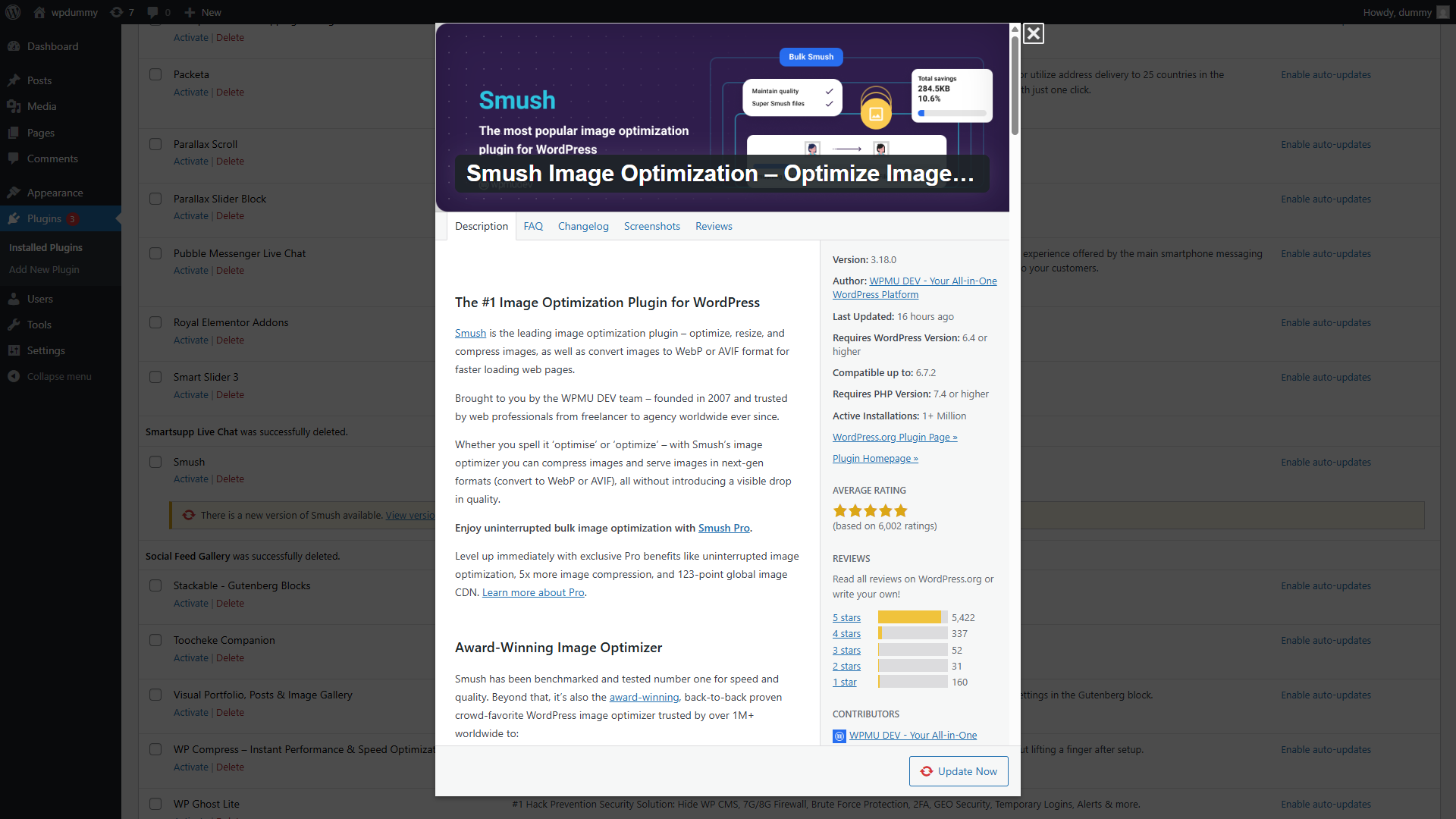Introduction
In the digital world, website speed and performance are crucial factors that affect user experience, SEO rankings, and conversion rates. One of the most effective ways to enhance a website’s performance is by optimizing images without compromising their quality. The Smush Image Optimization plugin for WordPress is a powerful tool that enables users to compress, resize, lazy load, and convert images into next-gen formats like WebP and AVIF. This article explores the features, benefits, installation, and practical use cases of the

What is Smush Image Optimization?
Smush is a widely popular WordPress plugin developed by WPMU DEV that allows website owners to optimize images effortlessly. It automatically compresses and resizes images without reducing quality, improving page load speeds and overall site performance. With over a million active installations, Smush is a go-to solution for WordPress users looking to enhance their website’s efficiency.
Key Features of Smush Image Optimization
Smush offers a comprehensive suite of features designed to optimize images and improve website performance. Below are its key functionalities:
1. Lossless Image Compression
Smush compresses images while preserving their visual quality. It removes unnecessary metadata and optimizes images without visible loss, ensuring they look great while loading faster.
2. Bulk Image Optimization
Users can optimize up to 50 images at a time with the free version, while the Smush Pro version allows unlimited bulk compression. This feature saves time and effort when managing large media libraries.
3. Lazy Load for Faster Page Speed
Lazy loading defers the loading of images until they are needed, reducing initial page load times and conserving bandwidth. This is particularly useful for content-heavy websites with multiple images.
4. WebP and AVIF Conversion
Smush supports conversion to WebP and AVIF, next-generation image formats that offer superior compression and quality retention compared to traditional JPEG and PNG formats. This results in faster-loading images and improved website performance.
5. Image Resizing
Users can set maximum dimensions for images, ensuring that oversized images are automatically resized before being uploaded. This prevents unnecessary storage usage and speeds up page loading times.
6. Automatic Optimization
Newly uploaded images are automatically compressed and optimized, eliminating the need for manual intervention. This ensures that all images maintain optimal performance without extra effort.
7. Image CDN for Faster Delivery (Pro Feature)
Smush Pro users get access to a global Content Delivery Network (CDN) that serves optimized images from the nearest server location. This improves load times for visitors regardless of their geographical location.
8. Backup and Restore (Pro Feature)
Before compressing an image, Smush Pro saves a backup, allowing users to restore the original image if needed. This provides an extra layer of security in case of accidental over-optimization.
9. Directory Smush
Smush can scan and optimize images outside the WordPress media library, such as theme and plugin images. This is useful for ensuring all website visuals are optimized for performance.
10. Multisite and WooCommerce Compatibility
Smush is fully compatible with WordPress Multisite and WooCommerce, making it ideal for businesses and large-scale eCommerce stores.
Benefits of Using Smush Image Optimization
Using Smush offers several advantages for WordPress users, including:
- Improved Page Speed: Faster loading times enhance user experience and lower bounce rates.
- SEO Boost: Google rewards fast-loading websites with better rankings.
- Reduced Bandwidth Usage: Optimized images consume less bandwidth, which is beneficial for sites with limited hosting resources.
- Automatic Optimization: Eliminates the need for manual image compression, saving time and effort.
- Enhanced Mobile Performance: Lightweight images improve performance on mobile devices.
- Increased Conversions: Faster-loading websites lead to higher engagement and conversion rates.
How to Install and Set Up Smush Image Optimization
Installing and configuring Smush on a WordPress website is straightforward. Follow these steps:
Step 1: Install the Smush Plugin
- Log in to your WordPress dashboard.
- Navigate to Plugins > Add New.
- Search for Smush Image Compression and Optimization.
- Click Install Now, then Activate the plugin.
Step 2: Configure Basic Settings
- Go to Smush > Dashboard.
- Enable Automatic Compression to ensure new images are optimized upon upload.
- Activate Lazy Load to defer offscreen images and boost page speed.
- Configure Image Resizing by setting a maximum width and height for uploaded images.
Step 3: Bulk Optimize Existing Images
- Navigate to Smush > Bulk Smush.
- Click Bulk Smush Now to optimize all images in the media library.
- If you need more optimizations, upgrade to Smush Pro for unlimited bulk compression.
Step 4: Enable WebP and AVIF Conversion
- Go to Smush > Settings > WebP.
- Toggle the WebP conversion option.
- Ensure your server supports WebP delivery (check with your hosting provider if needed).
Step 5: Test and Verify Optimization
- Open your website and test image loading speed.
- Use tools like Google PageSpeed Insights or GTmetrix to measure performance improvements.
- If needed, tweak settings to further optimize your images.
Use Cases for Smush Image Optimization
Smush is ideal for various types of WordPress websites, including:
ECommerce Stores
- Optimize WooCommerce product images to improve site performance.
- Use lazy loading to prevent slowdowns on category and product pages.
- Deliver next-gen image formats via CDN for faster mobile shopping experiences.
Blogs and News Websites
- Compress feature images and thumbnails for faster article loading.
- Enable lazy loading to improve content-heavy pages.
- Optimize author and contributor images to maintain consistency.
Photography and Portfolio Websites
- Retain high-quality visuals while reducing file sizes.
- Use WebP and AVIF formats for the best balance between quality and speed.
- Optimize images in custom directories, including theme assets and gallery plugins.
Corporate and Business Websites
- Improve homepage speed by optimizing hero images and banners.
- Ensure service page visuals load quickly for better user engagement.
- Use Smush Pro’s CDN to enhance global site accessibility.
Educational and Membership Sites
- Optimize course and tutorial images to improve platform performance.
- Reduce bandwidth usage for sites with a large number of registered users.
- Use lazy loading to enhance navigation speed across multiple lessons and modules.
Conclusion
Smush Image Optimization is an essential WordPress plugin for anyone looking to improve website speed, SEO, and user experience. With features like lossless compression, lazy loading, WebP conversion, and CDN integration, Smush provides an all-in-one solution for managing and optimizing images effortlessly.
By leveraging Smush’s powerful capabilities, WordPress site owners can significantly reduce page load times, enhance performance on mobile devices, and improve search engine rankings. Whether you run an eCommerce store, blog, portfolio, or business website, Smush ensures that your images are optimized for peak performance without sacrificing visual quality.
Investing in Smush Pro unlocks even more advanced features, including unlimited image compression, backups, and faster CDN delivery, making it a worthwhile upgrade for professional users.





